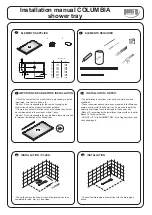
16
WARNING!
The outlet of the shower acts as
a vent and must not be connected
to anything other than the hose
and showerhead supplied.
PLUMBING CONNECTIONS
PLUMBING CONNECTIONS
Plumbing to be carried out before wiring
•
DO NOT
use jointing compounds on any
pipe fittings for the installation.
•
DO NOT
solder fittings near the shower unit
as heat can transfer along the pipework and
damage components.
• Compression fittings
MUST
be used to
connect to the inlet of the shower.
(Push-on fittings must
NOT
be used as full
engagement cannot be guaranteed).
NOTE:
An additional stopvalve (complying with
Water Regulations) must be fitted in the mains
water supply to the shower as an independent
means of isolating the water supply should
maintenance or servicing be necessary. If this
isolator is fitted in a loft space, the loft must
have a fixed access ladder and be boarded, with
appropriate lighting from the access point to the
isolator.
IMPORTANT:
Before completing the connection
of the water supply to the inlet of the shower,
flush out the pipework to remove all swarf
and system debris. This can be achieved by
connecting a hose to the pipework and turning
on the mains water supply long enough to clear
the debris to waste.
Procedure
• Turn off water supply either at the mains
stopvalve or the isolating stopvalve.
• Connect the mains water supply to the inlet
of the shower via 15mm copper, stainless
steel or plastic pipe using a 15mm x 15mm
compression fitting.
•
DO NOT
use excessive force when making
these connections.
• Make sure the backplate is square on the wall
and tighten the two retaining screws which
hold it to the wall.
• Turn on the mains water supply and check
for leaks in the pipework connection to the
shower.
NOTE:
At this stage no water can flow through
the unit.
NOTE:
Before fully tightening the inlet
connections, ensure that the pipework is
aligned for the chosen entry position.
Depending on the physical size of fittings
used, it may be necessary to trim the inlet
stem to accommodate the fitting.













































